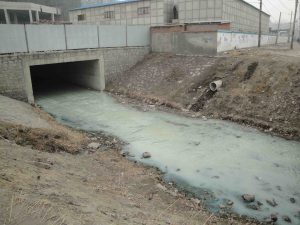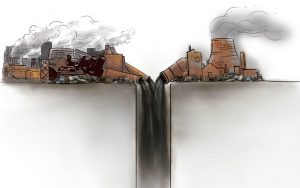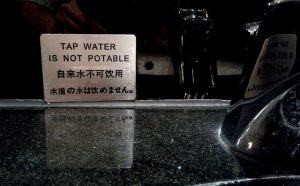What is the quality of Chinese drinking water? In the second half of 2009, the Chinese housing ministry carried out a nationwide survey of more than 4,000 water-treatment plants in cities at county level and above. Nearly four years later, it still hasn’t made any of this data public. However, several industry insiders have told us the results of this survey indicate only around half of the water meets standards. More than 30 years of rapid industrialisation has caused extensive pollution of water sources.
Gong Jing and Liu Hongqiao, who wrote this report, separately won the “Journalist of the Year” and “Young Journalist of the Year” categories at China Dialogue and The Guardian’s China Environmental Press Awards.
A month after their article was published, the housing ministry was forced to release previously unpublished information about urban water quality and officials announced they would be spending 410 billion yuan (about £40 billion) on improving water quality in urban areas by 2016.
In 1985, drinking water sources in China’s cities and towns were considered clean. By 2006, water sources had seriously deteriorated. The main pollutants in water sources for towns and cities had changed from microorganisms to soluble organic pollutants and heavy metal ions.
Many academics believe that China’s water pollution situation is even more serious than Europe’s during its period of industrialisation, and that pollution from rare earth metals is a particular problem in China. The “leakage” of heavy metal ions from smelting plants is a danger that has not yet been properly appreciated.
Wang Zhansheng, a professor at Tsinghua University’s School of Environment, believes that the harm done to the human body from dirty drinking water is of two kinds – the kind that can be seen, and the kind that cannot. The former is generally the harm that comes from contamination by microorganisms. It can cause sudden acute illness. Fortunately, Chinese people have a habit of drinking boiled water, which can kill microorganisms, so this is a less urgent problem.
The harm that cannot be seen is a more pressing issue. “Organic compounds can build up in the human body, and eventually they damage your health. In serious cases it can lead to cancer, birth defects and mutations,” said Wang.
The 2009 survey found that water-treatment plants that used surface water as the source of their tap water did not meet standards. Many had levels of fluorine, arsenic, iron and manganese that exceeded limits.
Wang said that a significant proportion of these organic compounds are environmental hormones, also known as endocrine disruptors. Environmental hormones pose four kinds of dangers: they can impair the immune system, affect fertility, cause cancer or interfere with the nervous system.
Liu Wenjun, head of the Institute of Drinking Water Safety Research at Tsinghua University, believes that public officials at all levels fail to understand the connection between drinking water and public health. Most know little about the long-term dangers of organic compounds because it may take 10 or 20 years before they cause sickness. It is also difficult to prove that this sickness came from drinking water in the first place.
Another misconception is that they believe that having a water dispenser in their home is a total solution. But there’s no escape from water pollution. A large number of studies have shown that, of the harmful substances found in water, only a third enters the body through drinking. The other two thirds are absorbed through the skin or inhaled – while bathing, washing and brushing your teeth.
The need for treatment
With only half of water sources reaching standards, the fact the water-treatment plants are using outdated technology has become the first hurdle to regaining control.
The first conventional water treatment technology appeared in Belgium in 1902. The process involved flocculation (adding aluminium polychloride), filtration (through quartz sand and pebbles, for example) and sterilisation. In 2004, the US National Academy of Engineering said that water-treatment technology was one of the most important inventions of the twentieth century.
Liu Wenjun told Caixin reporters that New York, and many cities in Canada and Europe, are still using this simple technology to supply drinkable water.
“The thing is that all these cities that are still using conventional technology are using water sources that are basically unpolluted. Most of China’s water sources are polluted, so this conventional technology is not suitable,” Liu said.
Conventional water purification methods aim to kill microorganisms. If the water is polluted with heavy metal ions or organic compounds, conventional technology can’t do anything. In the opinion of Song Lanhe, chief engineer at the housing ministry’s water monitoring unit, Japan and most European countries have been able to overcome relatively serious environmental pollution by using advanced water-treatment methods, such as ozone and activated carbon technology, to eliminate all kinds of organic and inorganic compounds.
Yet despite the severity of pollution of water sources, by the end of 2009, of the more than 4,000 water-treatment plants at or above country level, 98% were still using conventional technology. At present, only cities such as Beijing, Shanghai, Guangzhou, Shenzhen, Hangzhou and Zhengzhou are using advanced technology.
Beijing – which has the best quality tap water – has been heavily investing for 10 or more years to transform its water supply system, and still isn’t finished: the water is still not drinkable. And the outmoded network of water pipes in most cities and towns cannot be compared to Beijing’s infrastructure. Producing drinkable water is way beyond their reach.
The method of treatment is not the only consideration. After the water leaves the treatment plant, it flows into the urban network of water pipes, where it finally ends up coming out of household taps. On the way there are a lot of dangers: the outdated network of pipes as well as secondary water supplies can compromise water quality.
In 2002 and 2003, the housing ministry surveyed the network of water pipes in hundreds of cities and found it was universally sub-standard. “Outmoded pipe systems badly leak water, and secondary pollution is also likely to occur,” according to Song Lanhe. From 2000 to 2003, there were 4,232 cases of secondary pollution occurring in the pipe systems of 184 large- to medium-sized cities.
Liu Wenjun has been studying the problem of secondary pollution in the water pipe network for many years. His opinion is that outmoded pipe systems easily corrode, form scale, allow microorganisms and bacteria to breed, and react with nutrients in the water, creating secondary pollution. Occasionally it can even be seen with the naked eye – the water becomes yellow or black and may give off a bad smell.
Compared with developed nations, secondary water supply is a challenge unique to China. In China’s towns and cities, most buildings of six or more floors are high-rises. In order to provide normal water pressure for those homes, and at the same time avoid putting too much pressure on the fragile pipe network, all urban water supply companies chose a pipe network model where pressure is applied at the end: water is pumped to water tanks on the roofs of high-rises or cisterns in the basement. From here it flows into people’s homes and is thus a major potential source of secondary pollution; a dead mouse or bird can contaminate a building’s entire water supply.
The maintenance of these water tanks and cisterns is thus a major issue. Property rights generally belong to the residents, but residents certainly don’t have the skills to manage them. Usually it’s the property management of an estate that looks after them, but they don’t have the necessary specialised skills.
According to Song Lanhe, it is the urban buildings department that generally manages urban water-treatment plants. Theoretically, however, the secondary water supply facilities should be taken care of by the Department of Health. Water-treatment plants are unwilling “to meddle in others’ affairs” and so the Department of Health is also usually powerless to manage them. They are mainly involved in issuing sterilisation permits. In the end there is virtually no management of all these urban secondary water supply facilities, and no one to take responsibility.
But the secondary water supply is not without advantages. When an accident or disaster happens in a city and the power and water supplies are cut off, secondary water tanks can provide residents with water for a period of time, and they can also be used by firefighters as an emergency water source. Song sees their use as an urban management issue. If managed well, it’s a blessing; if managed badly, it’s a disaster.
The importance of clean drinking water was well expressed by a professional in the drinking water industry, who emphasised three points:
For the government, improving water supply is the most fundamental way of improving people’s lives, more fundamental than fixing roads, building high-speed railways or constructing high rises.
In the past few decades, it has become the most neglected way of improving people’s lives.
For every person, tap water is like air – you can’t choose it and you can’t escape from it.
Original article published in Caixin’s Century Weekly




